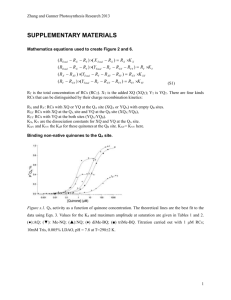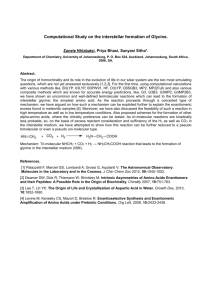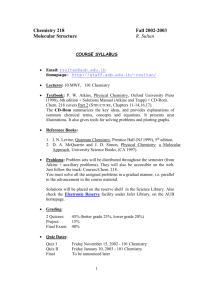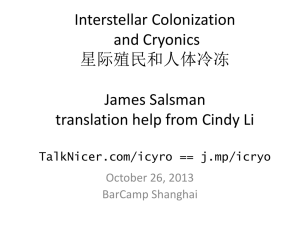Astrophysical Chemistry 2005
advertisement
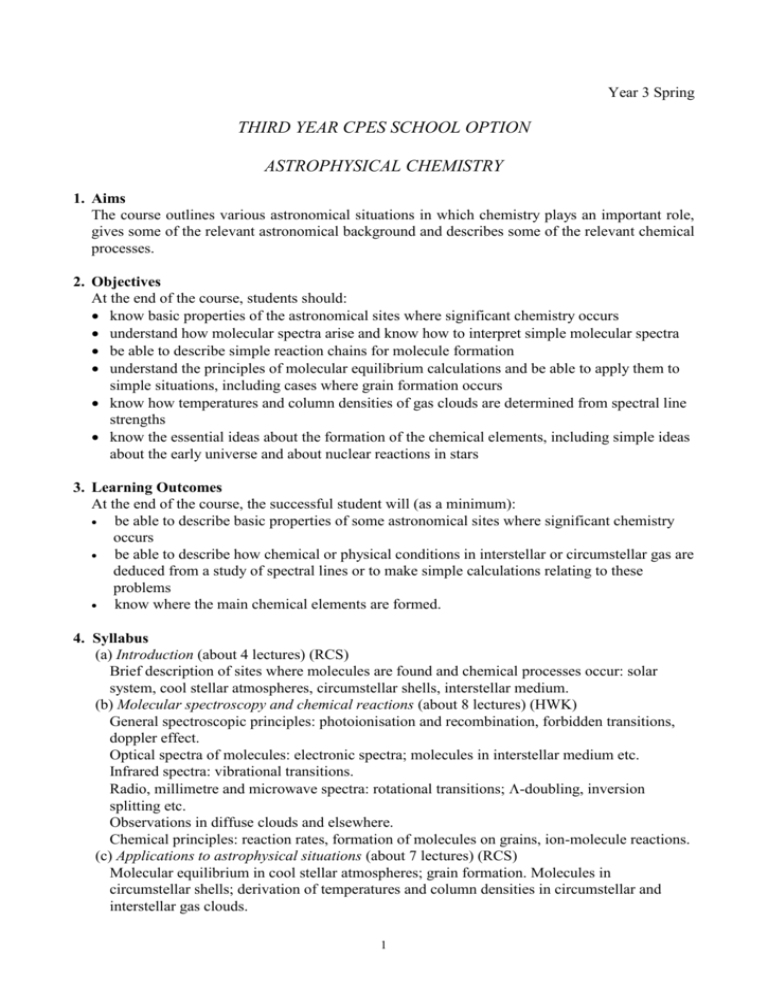
Year 3 Spring THIRD YEAR CPES SCHOOL OPTION ASTROPHYSICAL CHEMISTRY 1. Aims The course outlines various astronomical situations in which chemistry plays an important role, gives some of the relevant astronomical background and describes some of the relevant chemical processes. 2. Objectives At the end of the course, students should: know basic properties of the astronomical sites where significant chemistry occurs understand how molecular spectra arise and know how to interpret simple molecular spectra be able to describe simple reaction chains for molecule formation understand the principles of molecular equilibrium calculations and be able to apply them to simple situations, including cases where grain formation occurs know how temperatures and column densities of gas clouds are determined from spectral line strengths know the essential ideas about the formation of the chemical elements, including simple ideas about the early universe and about nuclear reactions in stars 3. Learning Outcomes At the end of the course, the successful student will (as a minimum): be able to describe basic properties of some astronomical sites where significant chemistry occurs be able to describe how chemical or physical conditions in interstellar or circumstellar gas are deduced from a study of spectral lines or to make simple calculations relating to these problems know where the main chemical elements are formed. 4. Syllabus (a) Introduction (about 4 lectures) (RCS) Brief description of sites where molecules are found and chemical processes occur: solar system, cool stellar atmospheres, circumstellar shells, interstellar medium. (b) Molecular spectroscopy and chemical reactions (about 8 lectures) (HWK) General spectroscopic principles: photoionisation and recombination, forbidden transitions, doppler effect. Optical spectra of molecules: electronic spectra; molecules in interstellar medium etc. Infrared spectra: vibrational transitions. Radio, millimetre and microwave spectra: rotational transitions; -doubling, inversion splitting etc. Observations in diffuse clouds and elsewhere. Chemical principles: reaction rates, formation of molecules on grains, ion-molecule reactions. (c) Applications to astrophysical situations (about 7 lectures) (RCS) Molecular equilibrium in cool stellar atmospheres; grain formation. Molecules in circumstellar shells; derivation of temperatures and column densities in circumstellar and interstellar gas clouds. 1 Interstellar medium: distribution in the Galaxy; H2 abundance. Cosmology: microwave background. Formation of light and heavy elements. Isotope abundances; origin of solar system. 5. Teaching Methods (a) Teaching activities There are two teaching periods each week, with a total of 19 sessions in the term. At least one of these will consist of a slide-illustrated review of astronomy. Because the two lecturers will be unavailable for certain periods of the term, the teaching timetable will not be entirely regular. A list of the times when each lecturer will be teaching is attached to this document; any variations will be announced beforehand in class if known in time. (b) Teaching and learning materials Each of the two lecturers will provide sets of examples and appropriate handouts. 6. Assessment (30% coursework and 70% unseen examination) Coursework assessment will consist of submitting solutions to the examples sheets by the dates set by the relevant lecturers. There will be a 1½ hour section in an unseen paper in the May third year examinations. You will have to answer 2 questions from a choice of 3. 7. Reading List There is no single book that covers the whole course. The following books may be found useful, although they also contain much that is not in the course. The most relevant references are starred. The books by Avrett, Chang and Duley & Williams are known to be out of print, but should be in the Main Library. Avrett, E.H. (ed) Chang, R. Cowley, C.R. Dyson, J.E. & Williams, D.A. Duley, W.W. & Williams, D.A. Morrison, D. & Owen, T. Frontiers of Astrophysics, chs 7 & 8 (Harvard University Press 1976) * Basic Principles of Spectroscopy, Ch. 7 (Krieger 1978) Introduction to Cosmochemistry (CUP 1995) * The Physics of the Interstellar Medium, 2nd edn, Chs 1--5, 8 (IOPP 1997) * Interstellar Chemistry (Academic Press 1984) * The Planetary System (Addison-Wesley 1988) There are also many popular articles. A few of these are: A. Dalgarno, The Molecules of Outer Space New Scientist, 23 June 1990, p.61 M. Grady & I. Wright, A Cosmic Cake Mix, New Scientist, 15 Sept 1990, p.46 T. Millar, Up the Starry Chimney, New Scientist, 31 Oct 1992, p.32 E. Herbst, Chemistry in the Interstellar Medium, Ann.Rev.PhysChem., 1995, 46, 27 D.A. Williams, Frontiers of Astrochemistry, Faraday Discussions of the Chemical Society, 1998, 109, 1 Molecules in space, Chemistry Review, 1998, pp.2-6 W.M. Irvine, The composition of interstellar molecular clouds, Space Science Reviews, 1999, 90, 203-218 E. Herbst, The Astrochemistry of H-3(+), Phil.Trans.Roy.Soc. A, 2000, 358 (1774), 2523-2533 P. Ehrenfreund & S.B. Charnley, Organic molecules in the interstellar medium, comets and meteorites: A voyage from dark clouds to the early earth, Ann.Rev.Astron.Astroph., 2000, 38, 427 2 I.W.M. Smith, Reaction kinetics at very low temperatures: Laboratory studies and interstellar chemistry, Acc.Chem.Res., 2000, 33 (5), 261-268 M.M. McCarthy & P. Thaddeus, Microwave and laser spectroscopy of carbon chains and rings, Chem.Soc.Rev., 2001, 177-185 E. Herbst, The chemistry of interstellar space, Chem.Soc.Rev., 2001, 168-176 H.J. Fraser, M.R.S. McCoustra & D.A. Williams, The molecular universe, Astron.Geophys., 43, 2.10-2.18 8. Name and location of course lecturers Professor Sir H W Kroto, Chichester Building 3R413 ( Kroto@sussex.ac.uk) Dr R C Smith, Arundel Building 206 ( R.C.Smith@sussex.ac.uk) Astrophysical Chemistry 2005 Timetable for lectures and lecturers Week: Monday 2.00 pm Pev I, 1B6 Tuesday 12 noon Pev I, 1B6 RCS RCS HWK HWK RCS RCS HWK HWK RCS HWK HWK HWK HWK RCS RCS RCS RCS RCS RCS (RCS) 1 10, 11 January 2 17, 18 January 3 24, 25 January 4 31 Jan, 1 Feb 5 7, 8 February 6 14, 15 February 7 21, 22 February 8 28 Feb, 1 Mar 9 7, 8 March 10 14, 15 March Bracketed date will probably not be needed. 3


